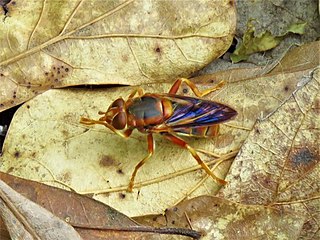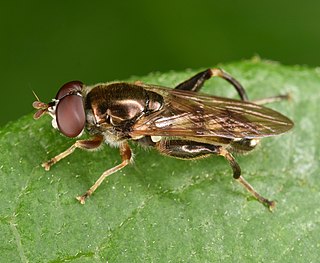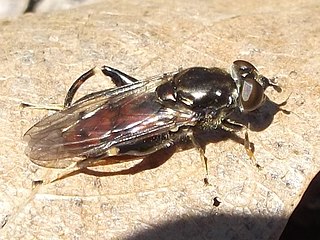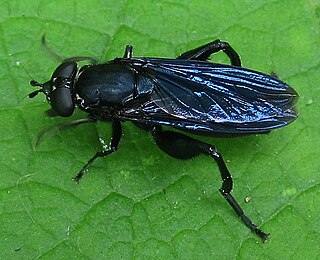
Callicera erratica , the Golden Pine Fly , is a rare species of syrphid fly observed in the Northeastern United States and Canada. Hoverflies can remain nearly motionless in flight. The adults are also known as flower flies for they are commonly found on flowers from which they get both energy-giving nectar and protein-rich pollen. Larvae live in water filled ratholes and cavities of old living conifers.
Criorhina verbosa, the Hairy-cheeked Bumble Fly, is an uncommon species of syrphid fly observed in the eastern to central northeastern United States. Hoverflies can remain nearly motionless in flight. The adults are also known as flower flies for they are commonly found on flowers, from which they get both energy-giving nectar and protein-rich pollen. The larvae of this genus are found in decaying wood.
Chalcosyrphus (Xylotomima) anthreas, the Yellow-banded Leafwalker, is a rare species of syrphid fly found in eastern North America. Hoverflies can remain nearly motionless in flight. The adults are also known as flower flies for they are commonly found on flowers, from which they get both energy-giving nectar and protein-rich pollen.

Temnostoma daochus , the Yellow-spotted Falsehorn, is a rare species of syrphid fly observed in the eastern United States. Hoverflies can remain nearly motionless in flight. The adults are also known as flower flies for they are commonly found on flowers, from which they get both energy-giving nectar and protein-rich pollen. Temnostoma adults are strong wasp mimics. The larvae burrow in moist decayed wood.

Blera badia, the Common Wood Fly, is a common species of syrphid fly first officially described by Walker in 1849. Hoverflies get their names from the ability to remain nearly motionless while in flight. The adults are also known as flower flies, for they are commonly found around and on flowers, from which they get both energy-giving nectar and protein-rich pollen. The larvae are of the rat-tailed type, feeding on exuding sap or in the rot holes of trees.
Criorhina bubulcus is a species of syrphid fly in the family Syrphidae.

Temnostoma venustum , the Black-banded Falsehorn , is a rare species of syrphid fly observed in the northeastern United States and adjacent Canada. Hoverflies can remain nearly motionless in flight. The adults are also known as flower flies for they are commonly found on flowers, from which they get both energy-giving nectar and protein rich pollen. Temnostoma adults are strong wasp mimics The larvae burrow in moist decayed wood.

Teuchocnemis bacuntius ,, the Orange Spur Fly , is a rare species of syrphid fly observed in eastern half of the United States. Syrphid flies are also known as Hover Flies or Flower Flies because the adults are frequently found hovering around flowers from which they feed on nectar and pollen. Adults are 13.5–18.1 mm (0.53–0.71 in) long, orange with a swolen hind femur and the hind tibia of the male with a ventral spur. The larvae are unknown.
Hadromyia aepalius, the Sterling Quicksilver, is a rare species of syrphid fly found in eastern North America. Hoverflies get their names from the ability to remain nearly motionless while in flight. The adults are also known as flower flies for they are commonly found around and on flowers, from which they get both energy-giving nectar and protein-rich pollen.

Chalcosyrphus (Xylotomima) metallicus, the Yellow-legged Leafwalker, is an uncommon species of syrphid fly observed in the southeastern United States. Hoverflies are able to remain nearly motionless while in flight. The adults are also known as flower flies for they are commonly found around and on flowers, from which they get both energy-giving nectar and protein-rich pollen.

Spilomyia alcimus, the Broad-banded Hornet Fly, is an uncommon species of syrphid fly first officially described by Walker in 1849. Hoverflies get their names from the ability to remain nearly motionless while in flight. The adults are also known as flower flies for they are commonly found around and on flowers, from which they get both energy-giving nectar and protein-rich pollen. The larvae are known as the short-tailed larvae suited for moist areas such as rot holes of trees.

Temnostoma balyras , the Yellow-haired Falsehorn , is a common species of syrphid fly observed in the eastern half of the United States and adjacent areas of Canada. Hoverflies can remain nearly motionless in flight. The adults are also known as flower flies for they are commonly found on flowers, from which they get both energy-giving nectar and protein-rich pollen. Larvae burrow in moist decayed wood using their hooks as rasping organs operated in a forwards and backwards motion by huge muscles housed in the mesothorax and metathorax. The larvae of T.balyras have been described by Heiss in "A classification of the larvae and puparia of the Syrphidae of Illinois exclusive of aquatic forms".

Chalcosyrphus (Xylotomima) libo, the Long-haired Leafwalker, is an uncommon species of syrphid fly observed in north-central North America. Hoverflies are able to remain nearly motionless in flight. The adults are also known as flower flies for they are commonly found around and on flowers, from which they get both energy-giving nectar and protein-rich pollen.

Chalcosyrphus (Xylotomima) piger, the short-haired leafwalker, is an uncommon species of syrphid fly found throughout North America and Europe. Hoverflies get their names from the ability to remain nearly motionless while in flight. The adults are also known as flower flies, for they are commonly found around and on flowers, from which they get both energy-giving nectar and protein-rich pollen. Larvae have been identified from sappy hollows from Larix and Pinus.
Blera notata , the Ornate Wood Fly, is a rare species of syrphid fly first officially described by Weidemann in 1830. Hoverflies get their names from the ability to remain nearly motionless while in flight. The adults, also known as flower flies for they are commonly found around and on flowers from which they get both energy-giving nectar and protein rich pollen. The larvae are of the rat-tailed type, feeding on exuding sap or in the rot holes of trees.

Chalcosyrphus (Xylotomima) chalybeus , the Violet Leafwalker, is a fairly common species of syrphid fly observed in the Northeastern United States. Hoverflies can remain nearly motionless in flight. The adults are also known as flower flies for they are commonly found on flowers, from which they get both energy-giving nectar and protein-rich pollen.
Xylota flavifrons ,, the Northern Leafwalker , is an uncommon species of syrphid fly observed in the northeastern United States and all across Canada. Syrphid flies are also known as Hover Flies or Flower Flies because the adults are frequently found hovering around flowers from which they feed on nectar and pollen. Adults are 9.4–14.7 mm (0.37–0.58 in) long. The larvae of this genus live under bark in sap runs.
Neoascia globosa , the Black-margined Fen , is a fairly common species of syrphid fly observed in northeastern North America. Hoverflies can remain nearly motionless in flight. The adults are also known as flower flies, for they are commonly found on flowers from which they get both energy-giving nectar and protein-rich pollen. The larvae are aquatic.
Parhelophilus porcus , the black bog fly, is an uncommon species of syrphid fly observed in Northern North America. Hoverflies can remain nearly motionless in flight. The adults are also known as flower flies for they are commonly found on flowers from which they get both energy-giving nectar and protein-rich pollen. The larvae are the long tailed "rat-tailed" type.
Trichopsomyia apisaon, the black-haired psyllid-killer, is a common species of syrphid fly observed all across North America. Hoverflies can remain nearly motionless in flight. The adults are also known as flower flies for they are commonly found on flowers from which they get both energy-giving nectar and protein-rich pollen. Larvae when known are psyllid, aphid and Phylloxera predators.











